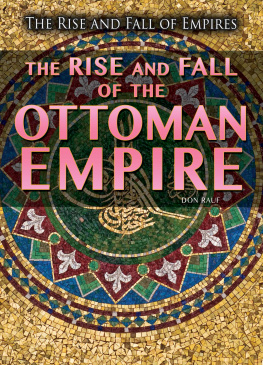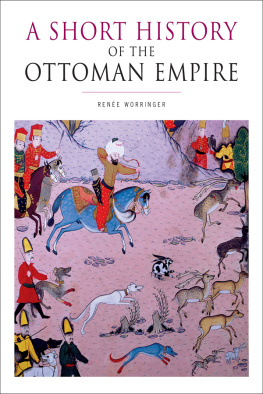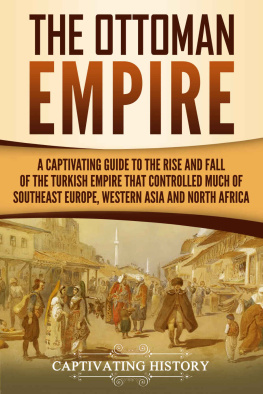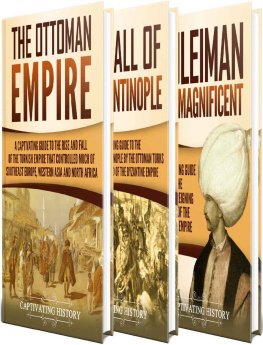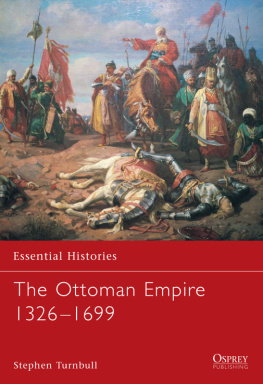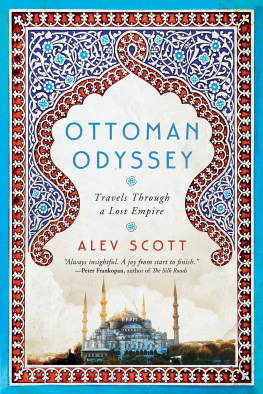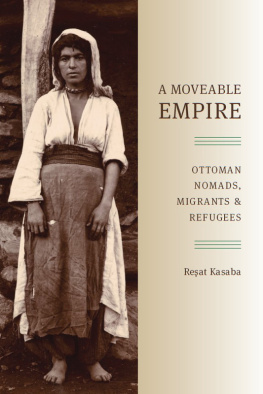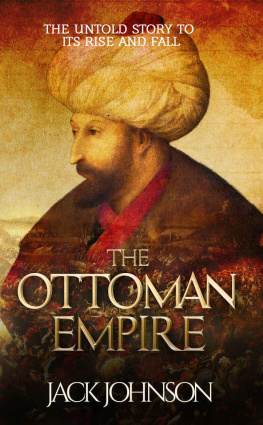Published in 2017 by The Rosen Publishing Group, Inc.
29 East 21st Street, New York, NY 10010
Copyright 2017 by The Rosen Publishing Group, Inc.
First Edition
All rights reserved. No part of this book may be reproduced in any form without permission in writing from the publisher, except by a reviewer.
Library of Congress Cataloging-in-Publication Data
Names: Rauf, Don, author.
Title: The rise and fall of the Ottoman Empire / Don Rauf.
Description: First edition. | New York : Rosen Publishing, 2017. | Series: The rise and fall of empires | Includes bibliographical references and index. | Audience: Grade 7 to 12.
Identifiers: LCCN 2015049239| ISBN 9781499463446 (library bound) | ISBN 9781499463422 (pbk.) | ISBN 9781499463439 (6-pack)
Subjects: LCSH: TurkeyHistoryOttoman Empire, 1288-1918. Classification: LCC DR485 .R38 2016 | DDC 956/.015dc23 LC record available at http://lccn.loc.gov/2015049239
Manufactured in China
Contents
CHAPTER 1 CHAPTER 2 CHAPTER 3 CHAPTER 4 CHAPTER 5
R uling for more than six hundred years, from 1299 until 1922, the Ottoman Empire was one of the biggest and longest-lasting empires in history. At its peak, it spanned from southern Europe and Africa through the Middle East and on to western Asia. This vast realm initially began as disconnected nomadic Turkish tribes. In time, however, these people came together under one great leader, Osman I, to form the beginnings of an organized culture that would grow to become a world power.

The Ottomans would control many crosscontinental trade routes. Although united by Islam, the Ottomans respected other religions and encouraged loyalty from other faith groups. In 1453, they would topple the last of the Byzantine Empire when they conquered its capital, Constantinople. Under the rule of Suleyman the Magnificent (who reigned from 1520 to 1566), the empire would reach its peak in terms of the arts, trade, government, unity, and multiculturalism. By recognizing minority groups and supporting their rights, while ruling with absolute control, the Ottomans developed a thriving nation.
Weak leadership, a sickly economy, and wars with neighboring Russia and other countries eventually led to the empire's decline. On the losing side at the end of World War I, the Ottoman Empire was replaced by the Turkish Republic, which continues to this day. The Ottomans left a legacy that included spreading and sustaining the Islamic religion. They also left behind a culture rich in ornate craftsmanship, which can be seen in their carpet weaving, pottery, and architecture. The Ottomans' most visible contribution might be one you see every day (especially if you live near a Starbucks): the coffeehouse.

T he people who eventually formed the Ottoman Empire could trace their roots back to Turkish nomads who traveled from place to place, always in search of better pastures for their livestock. These tribes began in north and northwestern China (Xinjiang) and Mongolia and the eastern part of central Asia. They lived in large expanses of open grasslands called the steppes, which extend all the way west to present-day Hungary. These lands provided food for their sheep, goats, horses, and camels. The grasslands were too dry to raise crops, so the nomads lived as herders. Because of their continuing need to move to a new location, they became skilled horsemen. They also grew to be great fighters, known for their speed and expert marksmanship with the bow and arrow.
To provide themselves with protection from harsh weather, they lived in portable tent-like structures called yurts. They would trade their animals or skins and furs for other products that they needed, such as grains or wood from agricultural communities. Sometimes they would simply raid villages and take supplies they needed.
As early as the sixth century, Chinese texts identified the Turkish nomads who would become the Ottomans. The Chinese gave these people the name Tujue. These nomadic people would gradually come together to establish a tribal kingdom Tu-Kue along the Orkhon River in Mongolia and south of Lake Baikal, which is the world's oldest and deepest freshwater lake. These tribes formed political entities called khanates that were headed by chiefs called khans. They lived under the authority of the Chinese Tang dynasty.
Starting in the 500s, khanates (such as the Uyghurs) came to control a portion of the trade routes known as the Silk Road, which extended all the way west to the Roman Empire. The Silk Road might be described as the first international commercial highway. Merchants transported silk, spices, and other commodities from China to Rome along these routes. Silk (made from silkworms) was especially valued in Rome. It was a fabric Romans did not know how to make and found much more comfortable and luxurious than other fabrics. The Turkish tribes found their power growing as they controlled the Silk Road, and they developed an appreciation for the value of the trade, which would continue in the Ottoman Empire.
THE INFLUENCE OF ISLAM
In 570, at the same time that these early Turkish tribes were rising in power, the prophet Muhammad was born in Mecca, which is now located in Saudi Arabia. According to religious history, Muhammad had a visitation from the angel Gabriel in 610, and over the next twenty-two years, the angel revealed the words of the Qur'an to him. The Qur'an is the holy book of the Islamic religion.

Muhammad and his followers spread the Islamic religion throughout the Arabian Peninsula. After Muhammad died in 632, his followers continued to disseminate his teachings for the next several hundred years through military expeditions, trade, and commerce. Shortly after Muhammad's death, Muhammad's supporters were divided over who should succeed the Prophet. A group called the Sunni believed that Islamic leadership should go to the person in the community deemed best to lead by the Muslim community. For the Sunni, the chain of leadership began with Muhammad's closest companion and then was passed to the "rightly guided" elite who became the first four caliphs (persons considered political and religious successors to the prophet Muhammad).
Another group called the Shia believed that leadership should remain directly within the family line of Muhammad. These views of Islam are at the heart of the Sunni and Shia split that still exists in modern times. Today about 85 to 90 percent of Muslims are Sunni, and 10 to 15 percent are Shia.
Before the Turkish people encountered Islam, they followed different religions. Early on, they worshiped many gods and nature spirits. Holy men called shamans communicated with these gods and spirits. Some early Turks believed in a heaven and a god that could give them luck and power. In the 700s, a Turkish people called the Uyghurs followed many different religions, including shamanism, Buddhism, and Christianity. In the 900s, the Islamic religion had reached the Uyghurs, and most converted. (Today, the Uyghur people number more than eight million and survive as a Muslim group in China. Their connection to modern Turks in the west can be heard in their Turkic language, which is very close to Turkish.)

